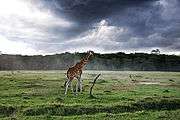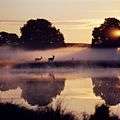Wildlife photography
Wildlife photography is a genre of photography concerned with documenting various forms of wildlife in their natural habitat. It is one of the more challenging forms of photography. As well as requiring sound technical skills, such as being able to expose correctly, wildlife photographers generally need good field craft skills. For example, some animals are difficult to approach and thus a knowledge of the animal's behavior is needed in order to be able to predict its actions. Photographing some species may require stalking skills or the use of a hide/blind for concealment.
While wildlife photographs can be taken using basic equipment, successful photography of some types of wildlife requires specialist equipment, such as macro lenses for insects, long focal length lenses for birds and underwater cameras for marine life. However, a great wildlife photograph can also be the result of being in the right place at the right time.[1]
History
In the early days of photography, it was difficult to get a photograph of wildlife due to slow lenses and the low sensitivity of photographic media.[2] In fact, it was not until 1906 that National Geographic published its first wildlife photos.[3] The photos were taken by George Shiras III, a U.S. Representative from Pennsylvania. Some of his photos were taken with the first wire-tripped camera traps.[4]
Definition
The world's three largest photography organisations, the Photographic Society of America, the Fédération Internationale de l'Art Photographique and the Royal Photographic Society have adopted a common definition for nature and wildlife photography to govern photography competitions, their respective presidents writing in a joint statement, "The development of a common definition for nature and wildlife photography will be an important step in helping photographers, many of whom enter competitions internationally, know what the rules are. It will also provide organisers with a very clear definition when they need to deal with the problem of ineligible images."[5]
Examples

 Monkey's affection
Monkey's affection Griffon vulture (Gyps fulvus), France
Griffon vulture (Gyps fulvus), France- Deer, Thrunelly Forest, Wayanad, Kerala

- Kerala bison, Bison Valley, Parambikulam, Kerala
 Coyote (Canis latrans), Yosemite National Park
Coyote (Canis latrans), Yosemite National Park_running.jpg) Eurasian brown bear (Ursus arctos arctos), Denmark
Eurasian brown bear (Ursus arctos arctos), Denmark- Monkey at Wayanad, Kerala
 Harry Opstrup, Dyrehaven, 1970
Harry Opstrup, Dyrehaven, 1970
See also
- BeetleCam
- Digiscoping
- Escape distance of animals
- High-speed photography
- National Wildlife Magazine
- Nature photographers
- Nature photography
- Project Noah
- Wildlife observation
References
- ↑ "animal picture society". animal picture society. Retrieved 7 February 2016.
- ↑ http://www.answers.com/topic/wildlife-photography
- ↑ http://photography.nationalgeographic.com/photography/photographers/first-wildlife-photos.html
- ↑ http://photography.nationalgeographic.com/photography/photographers/digital-camera-trap-article.html
- ↑ http://rps.org/news/2014/may/nature-definition-agreed Accessed 25 May 2014